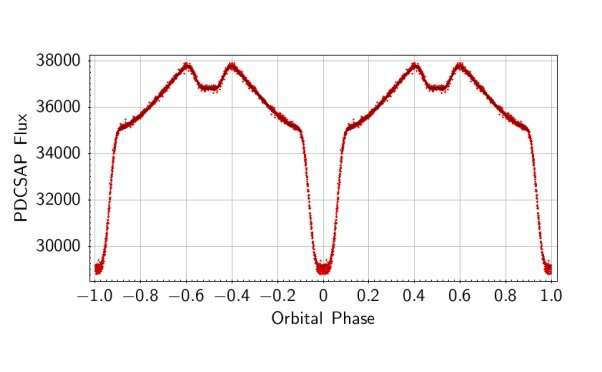November 3, 2020 report
New eclipsing binary system detected by Kepler spacecraft

An international team of astronomers reports the discovery of a new eclipsing binary system using NASA's Kepler spacecraft during its prolonged mission known as K2. The system, designated EPIC 216747137, appears to be a post-common-envelope binary (PCEB) of HW Virginis class. The finding is detailed in a paper published October 26 on arXiv.org.
Eclipsing binaries (EBs) are systems showing regular light variations due to one of the stars passing directly in front of its companion. Among PCEBs, HW Virginis stars are a specific type of EBs consisting of a hot subdwarf primary with an M-dwarf companion.
Recently, a high number of new HW Virginis systems have been discovered from the light curves of the OGLE and ATLAS projects. Astronomers expect even more detections of such systems using NASA's Transiting Exoplanet Survey Satellite (TESS). Expanding the sample of known HW Virginis binaries could be essential for advancing our knowledge about stellar evolution, especially when it comes to EBs.
Now, a team of astronomers led by Roberto Silvotti of the Observatory of Turin in Italy, reports the finding of a newest addition to the list of identified HW Virginis systems. EPIC 216747137 was observed by Kepler during the Campaign 7 of its K2 mission. The HW Virginis nature of this object was confirmed by follow-up observations using the South African Astronomical Observatory (SAAO), the La Silla Observatory, and the Nordic Optical Telescope (NOT).
"EPIC 216747137 is a new HW Virginis system discovered by the Kepler spacecraft during its K2 "second life", the paper reads.
The study found that EPIC 216747137 is a postcommon-envelope eclipsing binary consisting of a hot, evolved, sub-luminous star of sdOB spectral class and a cool low-mass M-dwarf companion. The system is located some 2,900 light years away and has an orbital period of just 3.87 hours, which causes a strong reflection effect from the secondary star.
The primary star has a radius of about 0.21 solar radii and is around 38 percent less massive than our sun. The hot component of the system has an effective temperature of approximately 40,400 K and rotational velocity at a level of 51 km/s.
When it comes to the secondary star, the researchers found that it has a radius of nearly 0.14 solar radii and a mass of about 0.11 solar masses. The M-dwarf has an effective temperature of about 3,000 K and is separated from the primary star by approximately 1.21 solar radii.
The researchers added that EPIC 216747137 lies just some 505 light years below the Galactic plane. According to them, this suggests that the system is a member of the Milky Way's thin disk.
"In order to check this assumption, we carried out a kinematical investigation calculating Galactic trajectories in a Galactic potential. The Galactic orbit is almost perfectly circular and the binary orbits within (though close to) the solar circle. Hence, we conclude that the binary belongs to the thin disc population, which is also confirmed by its position in the Toomre diagram," the authors of the paper explained.
More information: Silvotti et al., EPIC 216747137: a new HW Vir eclipsing binary with a massive sdOB primary and a low-mass M-dwarf companion. arXiv:2010.13524 [astro-ph.SR]. arxiv.org/abs/2010.13524
© 2020 Science X Network





















